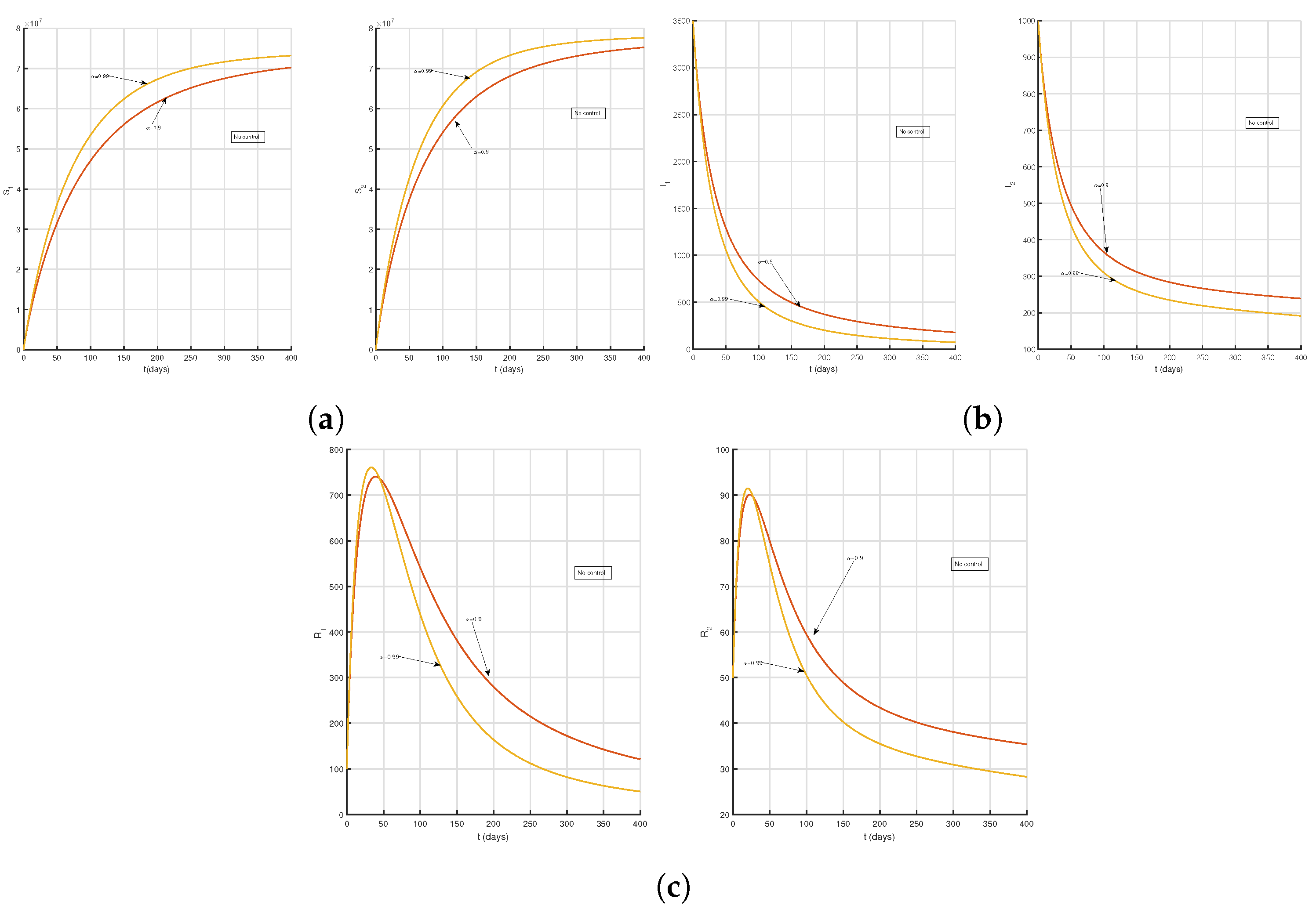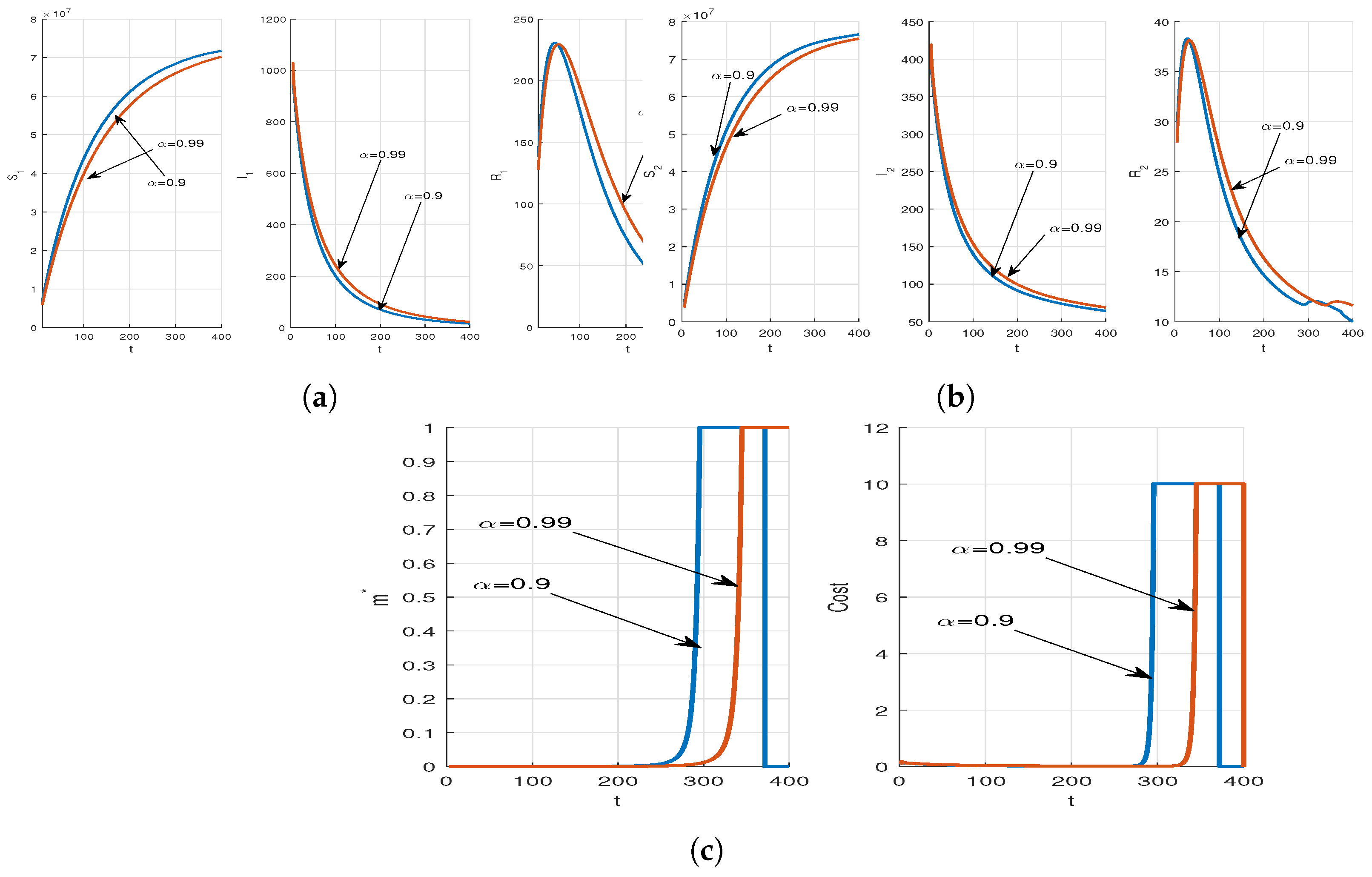1. Introduction
Mathematical models can play an important role in analyzing and studying different epidemiological issues. From epidemiological models, one can predict not only the dynamics of a disease but also the long-term behavior derived from the dynamical nature of early invasions, or, in fact, the influence of immunization on disease transmission. The Susceptible-Infectious-Recovered model, popularly known as the SIR model, is a fundamental epidemiological model used to analyze and predict the spread of infectious diseases within a population [
1]. This model partitions the populace into three compartments: people who are not yet infected but are in danger of contamination, people who are already infected with the disease and spread the sickness, and recovered people who have either endured contamination and acquired resistance or have capitulated to the illness.
Though the use of epidemiological models has skyrocketed with the growth of computing, there are a number of drawbacks when applying mathematical models. The SIR model assumes that individuals move through these compartments based on a set of differential equations capturing the dynamics of disease transmission. While the classic SIR model provides valuable insights into the general trends of an epidemic, it may oversimplify the complex spatial and temporal variations that often characterize real-world scenarios. To address this limitation, the concept of patch transfer has been introduced. It is undeniable that the inclusion of population dispersal in an epidemiological model makes it more realistic. Patch transfer extends the traditional SIR model by incorporating spatial heterogeneity into the analysis. Instead of treating the entire population as a homogeneous unit, the region under consideration is divided into patches, each representing a distinct subpopulation with its own set of infection dynamics. This approach allows for a more nuanced understanding of how infectious diseases spread across different geographical areas or social groups.
Incorporating patch transfer into the SIR model involves accounting for the movement of individuals between patches to reflect the mobility patterns observed in real-world populations [
2,
3,
4]. This addition enables researchers to explore how factors such as traveling, migration, and social interactions contribute to the spatial transmission of infectious diseases. By combining the classic SIR model with patch transfer, researchers can gain a more accurate and realistic representation of the dynamics of disease spread in diverse and interconnected populations. This enhanced model is particularly valuable for addressing public health challenges in regions with complex geographical and social structures, providing a more comprehensive foundation for designing effective intervention strategies and mitigating the impact of infectious diseases. A two-patch epidemic system refers to a mathematical model which is used to study the spread and dynamics of infectious diseases among two connected populations. In this system, two populations are connected by migration or movement; the spread of an infectious disease in one population can impact the other population. A two-patch epidemic system acts as a useful tool for studying the transmission dynamics of infectious diseases in various contexts, including the global spread of pandemics, the transmission of diseases between animal and human populations, and the impact of vaccination programs on disease spread [
5,
6]. Let us consider a real-life scenario of the cross-border spread of infectious diseases. Imagine that an infectious disease outbreak occurs in two neighboring countries, Country A and Country B. These countries have different population densities, healthcare infrastructures, and social behavioral patterns. People frequently travel between these countries for work, tourism, and other reasons. Features of both the countries are as follows:
Country A:
Higher population density
Advanced healthcare facilities
Urban areas with dense social interactions
Country B:
The infectious disease can spread within each country, with transmission rates influenced by population density [
7] and healthcare accessibility. People move between the two countries, facilitating the cross-border spread of the disease. Individuals infected in Country A may travel to Country B, introducing the disease to new areas. Conversely, individuals from Country B may travel to Country A, contributing to the spread of the disease in more densely populated regions. The model helps public health officials understand how the movement of people between different regions influences the overall spread of the disease. Each nation can develop strategies in order to manage and contain the epidemic while considering the distinct qualities of both urban and rural areas, as well as the effects of cross-border exchanges.
On the other hand, fractional calculus is a branch of mathematics that deals with the generalization of derivatives and integrals to non-integer orders [
8]. In recent years, it has been increasingly applied to epidemic models in order to capture the complex dynamics of infectious diseases [
9,
10]. The use of fractional calculus in epidemic systems has shown several effects, some of which are highlighted below:
Increased accuracy: the use of fractional calculus in epidemic models can provide a more accurate representation of the dynamics of infectious diseases. This is because it can capture long-term memory effects, which are not accounted for in traditional integer-order differential equations.
Increased complexity: fractional calculus introduces a new level of complexity to epidemic models, making them more challenging to analyze. This complexity can lead to the emergence of new behavioral patterns that are not present in traditional models.
Improved control strategies: fractional calculus can help design more effective control strategies for infectious diseases. This is because it can capture the impact of interventions such as vaccination campaigns and social distancing measures on the long-term dynamics of the disease [
11].
New insights into disease dynamics: the use of fractional calculus in epidemic models can provide new insights into the dynamics of infectious diseases. For example, it can help in order to explain why some diseases exhibit periodic outbreaks or why they show complex oscillatory behavior.
In real-life examples, the patch transfer concept in the SIR model helps capture the dynamics of an infectious disease spreading across borders while considering the distinct features of different regions and the movement of individuals between them. Using mathematical models, researchers can better understand how diseases spread and how interventions such as vaccination programs or travel restrictions can impact disease transmission. Additionally, the two-patch epidemic system can help policymakers to make informed decisions about how to allocate resources and respond to disease outbreaks in different populations. Overall, the two-patch epidemic system is an important tool for understanding the spread and dynamics of infectious diseases in interconnected populations and has the potential to inform public health interventions and policies aimed at controlling and preventing the spread of infectious diseases.
Today, fractional calculus is becoming increasingly popular for model simulation and for studying the complex nature of disease transmission. The use of fractional calculus in epidemic models can provide a more accurate and nuanced understanding of the dynamics of infectious diseases. It can help design more effective control strategies and offer new insights into the behavior of infectious diseases. Considering all of the above facts, we have constructed our model in the Caputo differential framework. In this context, the works of Das and Samanta [
9,
12,
13] on fractional order dynamics should be noted. Several academics have recently made substantial additions to the numerous SIR models in both integer and fractional order systems.
There are many examples of infectious diseases in which people’s movement has played a key role in the spread of the virus [
14,
15]. Consider the example of SARS; it had spread over almost all of China and several other regions of the world solely as a result of human movement. Moreover, the world has recently witnessed the pandemic situation caused by the COVID-19 coronavirus. Each and every country imposed strict restrictions on non-pharmaceutical interventions and people’s migration, whether within states or between countries. Numerous articles on COVID-19 have already been published, demonstrating how control measures and public awareness have reduced the disease load [
16,
17,
18]. Epidemic models intended to explain the dynamic behavior of disease propagation between patches have been presented and analyzed by Takeuchi et al. [
19], Wang and Wang [
20], Wang and Mulone [
21], and Wang and Zhao [
22,
23]. Other articles have been published in which researchers focused on epidemiological models in a two-patch environment under optimal treatment and vaccination [
4,
24]. Multi-city epidemic models were suggested by Wan and Cui [
25] and Arino and Vanden Driessche [
26] in order to investigate the dynamics of infectious illnesses. Another transport-related pandemic model with entrance and exit checks was examined by Liu et al. [
27]. In his study, Chen proposed an epidemic model with adaptive dispersal rates in order to observe how proper adaptation helps reduce disease load in connected groups or patches [
28]. The impact of population dispersal among ‘
n’ patches on the transmission of a disease was examined by Arino and Driessche [
26]. According to their numerical calculations, a disease that becomes endemic will not become extinct in two patches. It becomes extinct in two patches when people disperse within a certain range. Their simulation demonstrates how population dispersal might help in the eradication of endemic illnesses in isolated patches if the basic reproduction numbers of those patches are not very high and the contact rates between the two patches are not high either. Chen et al. [
29] presented an SIR model that includes illnesses due to transport. Despite the publications mentioned above, further study is required on epidemic models involving population dispersal. In the current study, we have examined an epidemic model that accounts for population dispersal across different locations. To keep things simple, we have merely taken into account the population distribution between the two cities. It is considered that susceptible and recovered people are free to move between these two regions, while there are strict restrictions on the people who are diagnosed to be infected. The main aim of our work is to observe how the infection level changes in each of the patches when people disperse at the optimal rate, which is considered to be time-dependent. Moreover, we have not restricted ourselves to the deterministic approach, and have also analyzed the fractional-order system.
We have organized this article into several sections. Model formations in both the integer-order system and fractional system are presented in
Section 2, followed by the establishment of the positivity and boundedness of the solutions of the integer-order system. Equilibrium analysis, sensitivity analysis, and stability analysis of the model are studied in
Section 4,
Section 5 and
Section 6, respectively. Next, we have presented our numerical simulations for the system (integer and fractional) in
Section 7 and
Section 8, respectively. In
Section 9, an optimal control problem has been proposed for both fractional and traditional integer-order systems, while the corresponding numerical studies of control problems are analyzed in
Section 10 and
Section 11, respectively. Finally, we have presented our conclusions in
Section 12.
2. Model Formulation
This article deals with a compartmental SIRS model in a two-patch environment where the population in each patch is infected with a disease. The susceptible and recovered populations are allowed to disperse between the patches, while there are strict restrictions for the infected population, who cannot leave their respective patches. It is assumed that the infected individuals are advised to live in their own patches. The total population in Patch-i
for
is subdivided into the three following compartments in each patch: the susceptible population
, infected population
, and recovered population
(see
Figure 1).
It is considered that the interaction between individuals is a mass action type and the population is homogeneously mixed in the environment; hence, the parameters
and
represent the disease transmission rates from susceptible to infected people in Patch-1 and Patch-2, respectively. The recruitment rate in Patch-1 is denoted by
, whereas for Patch-2 it is
. The natural mortality rates are parameterized by
and
, respectively, and are considered in each compartment of each patch. The parameters
and
denote the disease-induced death rates of Patch-1 and Patch-2, respectively, which are considered in the infected class of each patch only. The infected people gain immunity at a rate
in Patch-i (for
) either by natural immunity or by clinical treatment and then move to recovered class; however, as it is considered that the recovery is only temporary, a portion of the recovered people becomes susceptible again in Patch-i with a rate
for
. The term
m represents the dispersal speed of the population between two patches. The parameters
and
are the probabilities of dispersion of the susceptible population from Patch-2 to Patch-1 and from Patch-1 to Patch-2, respectively, while
and
are the probabilities of dispersion of the recovered population from Patch-2 to Patch-1 and from Patch-1 to Patch-2, respectively. A diagram in
Figure 1 is provided to show the epidemic model in a two-patch environment. It should be noted that in the absence of dispersal, i.e., when
, the population in each patch can evolve independently. Thus, the SIRS epidemic model with population-dispersal dynamics is described as follows:
Next, we consider the above SIRS model under the Caputo fractional order system framework. The main reasons behind our consideration are: (1) observing the impact of the long-term memory effect on the transmission dynamics of the SIRS model; (2) looking for better numerical results; and (3) studying the effect of fractional order to achieve a disease-free environment. When dealing with real-world problems, the Caputo derivative is very useful because it allows traditional initial and boundary conditions to be included in the formulation of the problem; moreover, the derivative of a constant is zero, which is not the case with the Riemann–Liouville fractional derivative. For this reason, we intend to consider the Caputo derivative.
Here,
is the Caputo fractional derivative operator of order
. The system (
2) is well balanced in the time dimension. For simplicity, we have omitted the power
in each parameter containing
. The system we intend to study is mentioned below:
Here,
are the initial stages of system (
3).
For an absolutely continuous function
),
is defined as
where,
is the Gamma function,
, and
n is a natural number. In particular, for
,
For
, the model (
2) is transformed into the model (
1).
4. Equilibrium Analysis
In this section, we first derive the basic reproduction numbers in both the presence and absence of population dispersal, then analyze the endemic equilibrium states. In a susceptible environment, the number of newly infected individuals generated from a single infected person is represented by
; in this work, we have followed the process developed by van den Driessche and Watmough [
30] to obtain
. Let us denote
for
and
for
.
Case I: Consider the situation when there is no population dispersal between the patches
. For
, systems (
1) and (
2) possess a disease-free equilibrium (DFE)
where
. The basic reproduction numbers for Patch-1 and Patch-2 in this case are found to be
and
, respectively.
The Patch-2 infection-free equilibrium in absence of population dispersal is noted as , where , while the Patch-1 infection-free equilibrium is , where . This shows that feasibility of and occurs according to and , respectively.
The endemic equilibrium point in absence of population dispersal is , where and . Thus, leads to the feasibility of and , respectively.
Case II: Next, we consider the situation in when people can disperse towards Patch-2 from Patch-1 but cannot move back to Patch-1 (i.e.,
). In this case, systems (
1) and (
2) possess a disease-free equilibrium (DFE)
, where
. Here, we obtain the basic reproduction number as
.
The Patch-2 infection-free equilibrium when is noted as , where , while Patch-1 infection-free equilibrium is , where . This shows that the feasibility of and occurs according to and , respectively.
Let us denote, and .
The endemic equilibrium point here is , where , , and .
Here, when and when . Thus, a disease can invade in Patch-2 even if the corresponding reproduction number lies below the unit value ().
Case III: In the next situation, people can disperse towards Patch-1 from Patch-2 but cannot move back to Patch-2 (i.e.,
). In this case, systems (
1) and (
2) possess a disease-free equilibrium (DFE)
where
. We obtain the basic reproduction number as
.
The Patch-2 infection-free equilibrium when is noted as , where , while the Patch-1 infection-free equilibrium is , where . This shows that the feasibility of and occurs according to and , respectively.
Let us denote, and .
The endemic equilibrium point here is , where , , and .
Here, when and when . Thus, a disease can invade in Patch-1 even if the corresponding reproduction number lies below the unit value ().
Case IV: Lastly, we consider the situation where people from both patches can disperse (i.e.,
). In this case, systems (
1) and (
2) possess a disease-free equilibrium (DFE)
where
.
Basic reproduction number : To obtain
in the presence of population dispersal, we can consider
. Then, we have
where
Here,
and
contain the compartment containing the new infection term and the other terms, respectively; thus, at the disease-free equilibrium
we have
The spectral radius of the next generation matrix
is
, and is provided by
The endemic equilibrium point is , where , , .
Let us consider . Then, we have and .
As , we have when and when .
When the population disperses among two patches, several different scenarios may occur: (IV.a), when Patch-1 shows SIRS epidemic dynamics but Patch-2 contains only the susceptible population; (IV.b), when Patch-2 shows SIRS epidemic dynamics but Patch-1 contains only susceptible population; (IV.c), when Patch-1 shows a SIRS epidemic dynamics but Patch-2 is infection-free; and (IV.d), when Patch-1 shows a SIRS epidemic dynamics but Patch-2 is infection-free.
(IV.a) Patch-2 infection-free equilibrium , where, and .
Here, . Thus, only when .
(IV.b) Patch-1 infection-free equilibrium . where . and .
Here. . Thus, only when .
Altogether, we have come up with equilibrium points for different situations that may occur due to population dispersal, before becoming infected or after recovery. It is observed here that even if the basic reproduction number of one patch becomes less than 1, the whole system may become infected. Moreover, it has been noted prominently from the model (
2) that almost all parameters contain
as a power which implies that the reproduction number clearly depends on
for the fractional-order system.
6. Stability Analysis
The local stability conditions for the equilibrium points of systems (
1) and (
2) are discussed in this section. The Routh–Hurwitz criterion helps to derive the stability conditions of the system (
1), whereas the stability conditions for system (
2) follow from the results stated in Theorem A2 of
Appendix B. According to this criterion, an equilibrium point is said to be locally asymptotically stable (LAS) if its corresponding Jacobian matrix provides eigenvalues with negative real parts. Let
for
and let
for
.
Case I: Consider the case when the population at each patch is not allowed to disperse from one patch to another (). Here, Patch-1 and Patch-2 act as independent regions.
Theorem 3. In the absence of population dispersal, the disease-free equilibrium of the proposed system is locally asymptotically stable (LAS) for for Patch-1 and for Patch-2.
Proof. The Jacobian matrix of systems (
1) and (
2) in the absence of population dispersal is provided as follows:
This provides the eigenvalues , which are always negative; the other two eigenvalues are and . Thus, and will be negative only when , . Moreover, the arguments of all eigenvalues will be if , . Hence, is locally asymptotically stable for both systems when for Patch-1 and for Patch-2. □
Theorem 4. In the absence of population dispersal, the endemic equilibrium of the proposed system is locally asymptotically stable (LAS) for for Patch-1 and for Patch-2.
Proof. At
, the Jacobian matrix is
The eigenvalues are roots of the following characteristic equation:
Thus, the eigenvalues have negative real parts if
and
, and the arguments of all the eigenvalues lie in the second or third quadrant, in this case as
. Consequently, it can be stated that
is locally asymptotically stable in both system (
1) and system (
2) when
and
hold. □
Similarly, we can analyze the stability of the system around and using the nature of eigenvalues of the corresponding Jacobian matrices.
Case II: Consider the case when the population from Patch-1 can disperse towards Patch-2 but cannot move back to Patch-1 again ().
Theorem 5. If people are not allowed to disperse to Patch-1, then the disease-free equilibrium of systems (1) and (2) is locally asymptotically stable (LAS) for for Patch-1 and for Patch-2, i.e., . Proof. The Jacobian matrix of systems (
1) and (
2) when people can not disperse to Patch-1 is provided as follows:
From the Jacobian matrix, we have the two eigenvalues
and
. The rest of the eigenvalues are
, and
, which are always negative. Thus,
and
when
,
, respectively. For all eigenvalues,
here; thus,
is locally asymptotically stable for both systems when
and
hold simultaneously, i.e.,
. □
Theorem 6. The endemic equilibrium of the proposed systems (1) and (2), if it exists, is locally asymptotically stable (LAS). Proof. The Jacobian matrix at endemic equilibrium point
is provided as follows:
The characteristic equation corresponding to
is
where
Here, the characteristic equation provides all of the eigenvalues with negative real parts for feasible and . In addition, the arguments of all the eigenvalues lie in the second or third quadrant in this case, i.e., . Thus, it can be stated that , whenever it exists, is locally asymptotically stable. □
Similarly, we can analyze the stability of the system around and using the nature of eigenvalues of the corresponding Jacobian matrices.
Case III: Consider the case when the population from Patch-2 can disperse towards Patch-1 but cannot move back to Patch-2 again ().
Theorem 7. If people are not allowed to disperse to Patch-2, then the disease-free equilibrium of systems (1) and (2) is locally asymptotically stable (LAS) for for Patch-1 and for Patch-2, i.e., . Proof. The Jacobian matrix of systems (
1) and (
2) when people can not disperse to Patch-2 is provided as follows:
Here, we have the two eigenvalues
and
. The rest of the eigenvalues are
, and
, which are always negative. The arguments of all the eigenvalues of the characteristic equation lie in the second or third quadrant, i.e.,
in this case. Thus,
is locally asymptotically stable when
and
hold simultaneously for both system (
1) and system (
2), i.e.,
. □
Theorem 8. The endemic equilibrium of the proposed systems (1) and (2), if it exists, is locally asymptotically stable (LAS). Proof. The Jacobian matrix at endemic equilibrium point
is provided as follows:
The characteristic equation corresponding to
is
where
Here, the characteristic equation provides all of the eigenvalues with negative real parts for feasible
and
. Thus, all of the eigenvalues have negative real parts and the arguments of all the eigenvalues lie in the second or third quadrant. Therefore,
, and it can be stated that
, whenever it exists, is locally asymptotically stable. □
Similarly, we can analyze the stability of the system around and using the nature of eigenvalues of the corresponding Jacobian matrices.
Case IV: Consider the case when the population is allowed to disperse between the patches. Here, susceptible and recovered people can disperse among Patch-1 and Patch-2 ().
Theorem 9. In the presence of population dispersal, the disease-free equilibrium of systems (1) and (2) is locally asymptotically stable (LAS) for and , i.e., . Proof. The Jacobian matrix of systems (
1) and (
2) in the presence of population dispersal is provided as follows:
From the Jacobian matrix we have the two eigenvalues
and
. Thus,
and
hold when
and
, respectively. The other eigenvalues are roots of the equation
Here, all the roots will only have negative real parts, which leads to the conclusion that the arguments of all the eigenvalues should be greater than . Consequently, is locally asymptotically stable when and , i.e., . □
Theorem 10. The endemic equilibrium of the proposed system, if it exists, is locally asymptotically stable.
Proof. The Jacobian matrix at endemic equilibrium point
is provided as follows:
The characteristic equation corresponding to
is
where
Here, the characteristic equation provides all of the eigenvalues with negative real parts for feasible and . Thus, it can be stated that , whenever it exists, is locally asymptotically stable if and , and the arguments of all the eigenvalues lie in the second or third quadrant (i.e., ). □
Theorem 11. The equilibrium point of the proposed system is locally asymptotically stable for .
Proof. The Jacobian matrix at endemic equilibrium point
is provided as follows:
From the Jacobian matrix, we have one eigenvalue,
; thus,
holds when
. The other eigenvalues are roots of the characteristic equation corresponding to
, which is
where
Here, the characteristic equation provides all of the eigenvalues with negative real parts for a feasible equilibrium point. Thus, it can be stated that is locally asymptotically stable if , and the arguments of all the eigenvalues lie in the second or third quadrant (i.e., ). □
Theorem 12. The equilibrium point of the proposed systems (1) and (2) is locally asymptotically stable for . Proof. The Jacobian matrix at endemic equilibrium point
is provided as follows:
From the Jacobian matrix, we have one eigenvalue,
; thus,
holds when
. The other eigenvalues are the roots of the characteristic equation corresponding to
, which is
where
Here, the characteristic equation provides all of the eigenvalues with negative real parts for a feasible equilibrium point. Thus, it can be stated that is locally asymptotically stable if , and the arguments of all the eigenvalues lie in the second or third quadrant (i.e., ). □
7. Numerical Simulation of System (1) without Implementation of Control Strategy
In this section, we validate the analytical results through numerical simulation. The scenarios presented here can help to visualize the dynamical behavior of the system in both the presence and absence of population dispersal. The parametric values used in this section are listed below in
Table 1.
First, we discuss the situation when the population does not disperse between patches;
Figure 2 depicts this scenario. Choosing
, it is observed that the system converges to an infection-free state for both the patches, we obtain a stable
, and the basic reproduction number
becomes
(see
Figure 2a). Now, if
starts to increase, then
becomes a saddle point and we can observe that the infection invades Patch-1. In
Figure 2b, we obtain the basic reproduction number as
for
and obtain a stable steady state containing an infection-free Patch-2 and infected Patch-1
. On the other hand, if
is increased instead of
, then we can observe that the infection invades Patch-2. In
Figure 2c, we obtain the basic reproduction number as
for
and obtain a stable steady state containing an infection-free Patch-1 and infected Patch-2
. Now, if both
and
increase, then we have an infected system even if people do not disperse between the two patches.
Figure 2d depicts the scenario at
, where both Patch-1 and Patch-2 are infected with the disease and we obtain a stable
with
.
Next, we discuss the case when the population from Patch-1 can disperse towards Patch-2 but cannot move back to Patch-1 again (
);
Figure 3 depicts this scenario. Choosing
, it is observed that the system converges to an infection-free state for both patches, we obtain a stable
, and the basic reproduction number
becomes
(see
Figure 3a). From this situation, if
starts to increase then
becomes a saddle point and we can observe that the infection invades in Patch-1. In
Figure 3b, we obtain the basic reproduction number as
for
and obtain a stable steady state containing an infection-free Patch-2 and infected Patch-1
. On the other hand, if
is increased instead of
, then we can observe that the infection invades in Patch-2, while Patch-1 remains infection-free. In
Figure 3c, we obtain the basic reproduction number as
for
and obtain a stable steady state containing an infection-free Patch-1 and infected Patch-2
. If both
and
increase, then we have an infected system even if people do not disperse between the two patches.
Figure 3d depicts the scenario at
, where both Patch-1 and Patch-2 are infected with the disease and we obtain a stable
with
.
Next, we discuss the case when the population from Patch-2 can disperse towards Patch-1 but cannot move back to Patch-2 again (
);
Figure 4 depicts this scenario. Choosing
, it is observed that the system converges to an infection-free state for both the patches, we obtain a stable
, and the basic reproduction number
becomes
(see
Figure 4a). Now, increasing the value of
leads to instability as
becomes saddle, and we can observe that the infection invades in Patch-1. In
Figure 4b, we obtain the basic reproduction number as
for
and obtain a stable steady state containing an infection-free Patch-2 and infected Patch-1
. On the other hand, if
is increased instead of
, then we can observe that the infection invades Patch-2 while Patch-1 remains infection-free. In
Figure 4c, we obtain the basic reproduction number as
for
and obtain a stable steady state containing an infection-free Patch-1 and infected Patch-2
. Now, if both
and
increase, then we have an infected system even if people do not disperse between the two patches.
Figure 4d depicts the scenario at
, where both Patch-1 and Patch-2 are infected with the disease and we obtain a stable
with
.
Figure 5, shows the scenario when the population disperses between Patch-1 and Patch-2 (
). Choosing
, it is observed that the system converges to an infection-free state for both patches, we obtain a stable
, and the basic reproduction number
becomes
(see
Figure 5a). Now, this stable behavior of
switches with increasing value of
as the equilibrium becomes saddle, and we obtain a scenario where the infection invades in Patch-1. In
Figure 5b, we obtain the basic reproduction number as
for
and obtain a stable steady state containing an infection-free Patch-2 and infected Patch-1
. On the other hand, if
is increased instead of
, then we can observe that the infection invades Patch-2 while Patch-1 remains infection-free. In
Figure 5c, we obtain the basic reproduction number as
for
and obtain a stable steady state containing an infection-free Patch-1 and infected Patch-2
. Now, if both
and
increase, then we have an infected system even if people do not disperse between the two patches.
Figure 5d depicts the scenario at
, where both Patch-1 and Patch-2 are infected with the disease and we obtain a stable
with
. Moreover, from
Figure 2d and
Figure 5d it can be observed that although the infected population count has increased slightly in Patch-1 in the presence of population dispersal, it has significantly decreased in Patch-2. Moreover, the highest number of recovered individuals is obtained in Patch-1
when people can disperse between the patches.
In
Figure 6, we have analyzed the sensitivity of some of the system parameters in disease transmission, and have calculated corresponding sensitivity indices for the parametric values in
Table 1 with
. The fact that the spread of the disease has a greater ascendancy for
than
can be observed in
Figure 6a. Moreover, an increase in the disease transmission rates
actually proliferates the illness in a system, as the chances of spreading the infection become higher. On the other hand, for the chosen parametric values there is an inclination in the basic reproduction number for Patch-1
and a declination for Patch-2
with the increase in the population dispersal speed
. In addition, if more people move towards Patch-1
, then the prevalence of the illness in that patch is expanded, while in the other patch, the spread is somewhat more controlled. Furthermore, the inversely proportional relationship of
with
indicates that the epidemic situation in Patch-1 can be controlled by increasing people’s movement towards Patch-2. However, the infectivity in Patch-2 will increase in this case.
Figure 6b contains the sensitivity indices for the parametric values in
Table 1, which are calculated as follows:
and
,
,
. On the other hand,
Figure 6c indicates that the spread of disease has an ascendency for increasing
.
In
Figure 7, we have plotted the count of infected people in Patch-1
and Patch-2
for different movement scenarios. We mainly considered three scenarios: (i) people move to Patch-2 in larger numbers
; (ii) people move to Patch-1 with larger probabilities
; and (iii) the probabilities are same for both patches
.
Figure 7a shows that the count of infected people in Patch-1 is lowest when both susceptible and recovered people move to Patch-2, and that this situation leads to an inclination in the infectivity there (see
Figure 7b). In fact, higher population dispersal probabilities (either of susceptible, recovered, or both) towards Patch-1 suppress the infection level in Patch-2 even for smaller dispersal speeds.
12. Conclusions
When it comes to population dispersal, infectious diseases tend to be a cause for concern. In densely populated areas, respiratory diseases such as flu or COVID-19 have a tendency to be highly infectious, as they can spread very quickly. There are several other aspects that causes high transmission. It includes mode of transmission, period of infectivity, efficacy of implemented preventative measures, etc., which can be taken into account. In order to control the spread of disease during population movement or traveling, public health is essential. The migration of people, which has increased with time and growing socioeconomic conditions, expanding tourism, etc., acts as a contributing factor. This movement alleviates the spread of an infectious disease; thus, analyzing an epidemic model in the presence of population dispersal is of utmost importance.
In this work, a compartmental SIRS model has been proposed in a two-patch environment, where it is assumed that only susceptible and recovered populations are allowed to disperse between the patches. A deterministic model and a fractional-order system are analyzed here in order to observe the detailed dynamical scenario. Four situations are taken into consideration while analyzing the equilibrium points of the system: (i) no dispersal between the patches; (ii) people can travel from Patch-1 to Patch-2 but cannot move back to Patch-1; (iii) people can travel from Patch-2 to Patch-1 but cannot move back to Patch-2; and (iv) people can freely disperse between the two patches. In these cases, we respectively reach a disease-free equilibrium state, an infection-free Patch-2 and infected Patch-1 state, an infection-free Patch-1 and infected Patch-2 state, and an infected state in which both patches are infected. The numerical scenario shows that the disease transmission rates in both patches play significant roles in the stability of the system, as adjusting these parameters decides whether the disease will invade the patch or not. It is notable that although the infected population count increases slightly in Patch-1 in the presence of population dispersal, it significantly decreases in Patch-2. For the chosen parametric values, the results depict that there is an inclination in the basic reproduction number for Patch-1 and a declination for Patch-2 with the increase in the population dispersal speed . In the later part of the paper, a corresponding optimal control problem is formulated in which the dispersal speed of the population is considered to be time-dependent instead of a constant value. The numerical scenario reveals that the count of the infected population increases in Patch-1 and declines in Patch-2 in the presence of optimal dispersal, and that the highest number of recovery cases has been obtained in both patches.
In the model simulation, fractional order has a noticeable impact. It is noteworthy that when the derivative order decreases, the recovery rate increases. Both patches have a comparable rise in the infected population, although at a lower derivative rate. In the control situation, the order of derivatives is less, and the optimal state is reached faster. These effects can be quite useful when trying to fit actual data into real-life scenarios.
While the model proposed here has shown some interesting dynamical behavior, there are many remaining items that can be implemented later as an extension of this work. In this work, we have only dealt with the deterministic and fractional approaches; environmental stochasticity has not been incorporated here. It would be interesting to explore whether Gaussian noise plays a significant role in this dispersed epidemic model. Secondly, we have only considered scenarios in which susceptible and recovered people are allowed to move between two patches; any asymptomatic or pre-symptomatic stage has not been considered here. It is quite evident that people belonging to these stages shall also move between the patches, and so the future researchers can possibly observe the impact of this movement on the dynamics of the system. Moreover, a certain amount of time is required for a person to be infected with a certain type of virus. As it is not an instantaneous process, consideration of a delay parameter can make the model more realistic. The present work can be studied further by incorporating the facts mentioned above in order to observe various realistic dynamical behaviors.

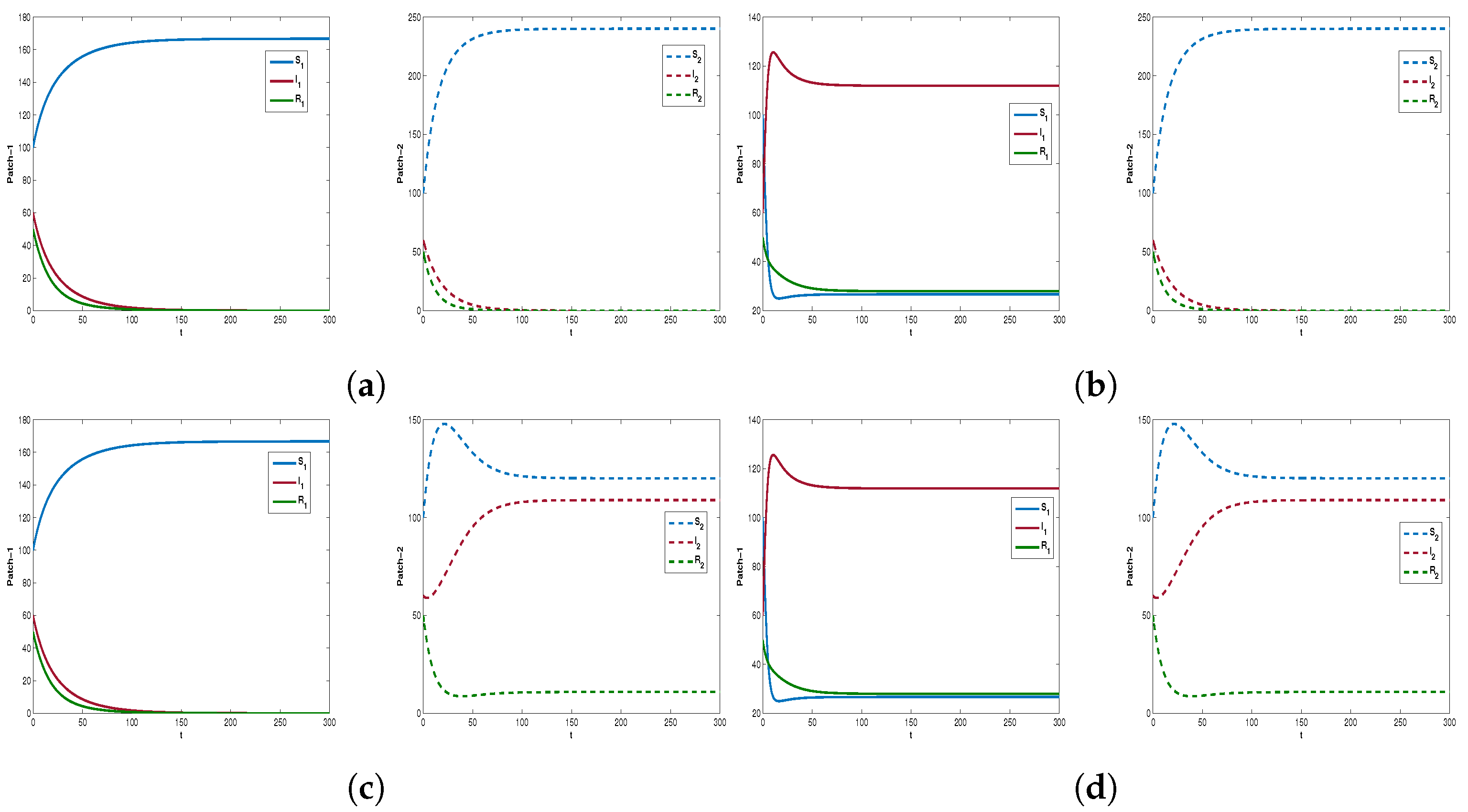

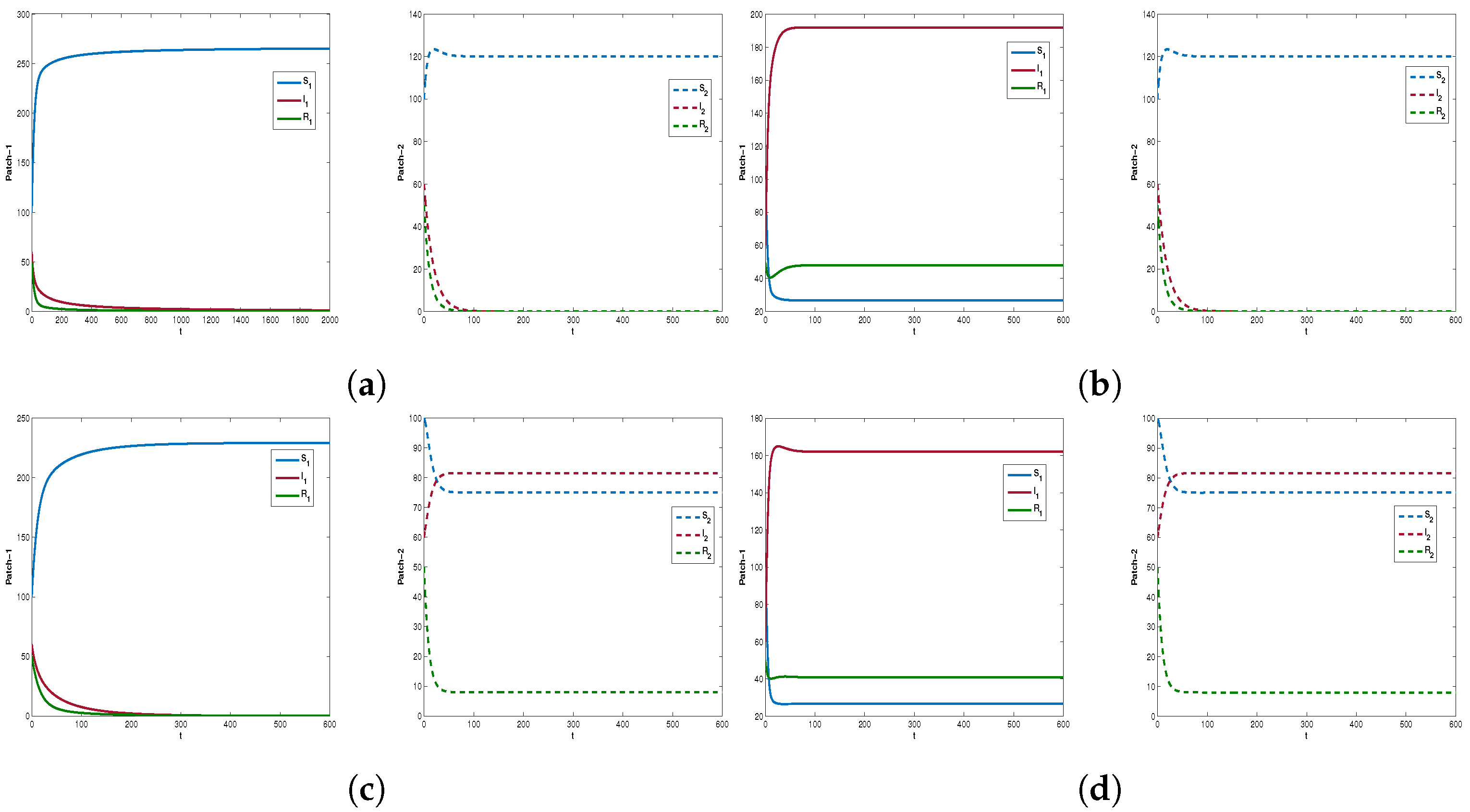

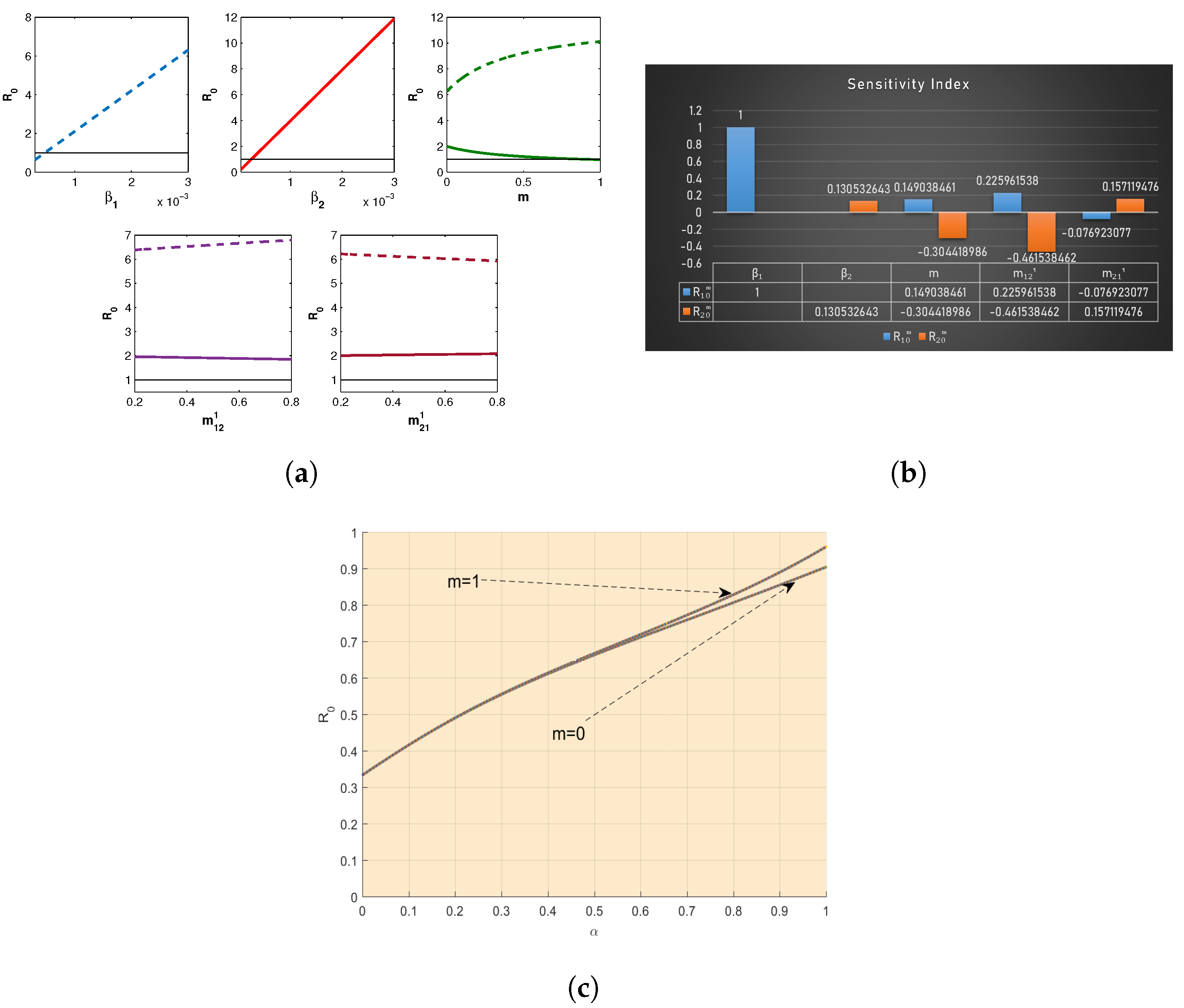
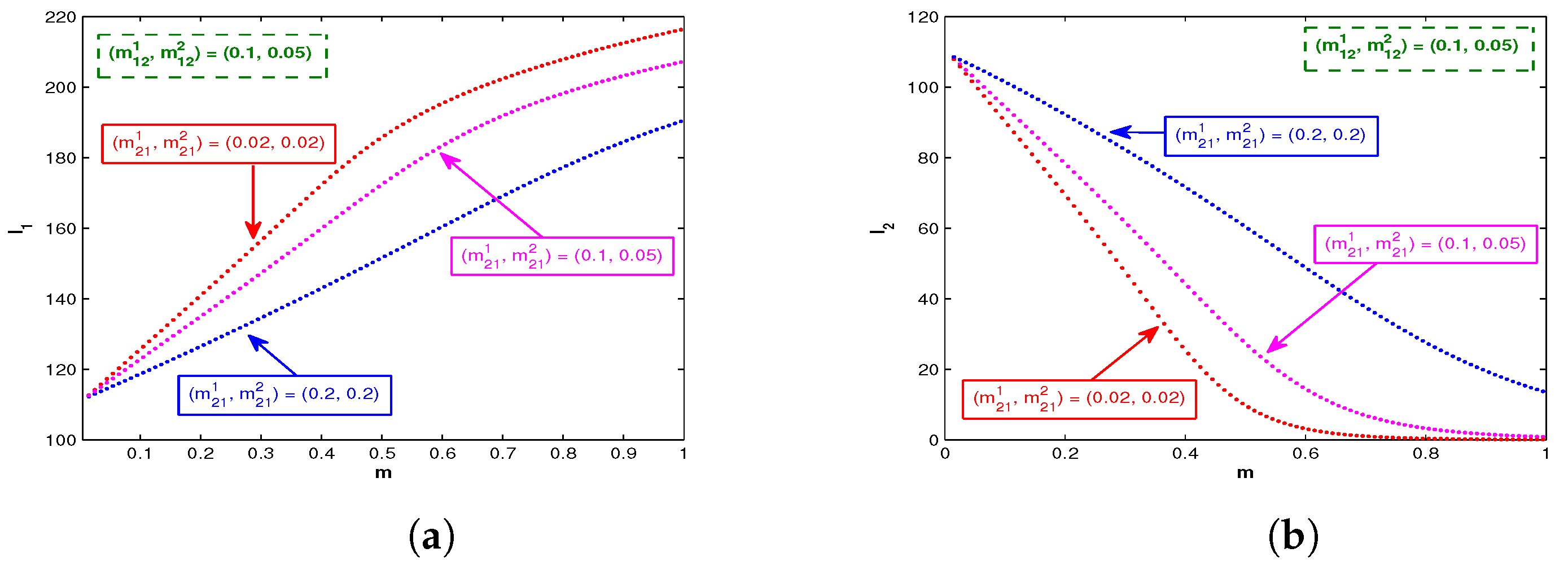
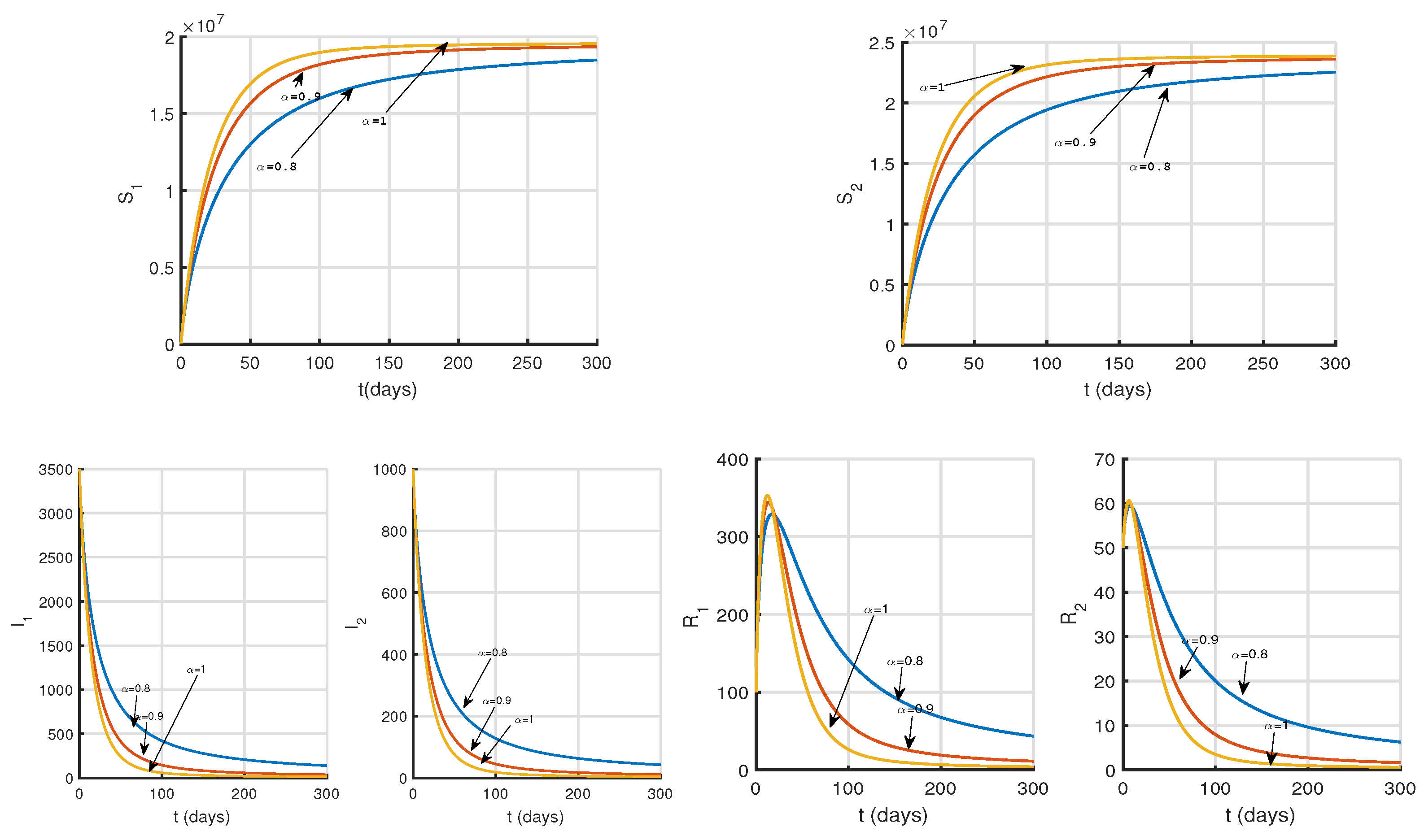
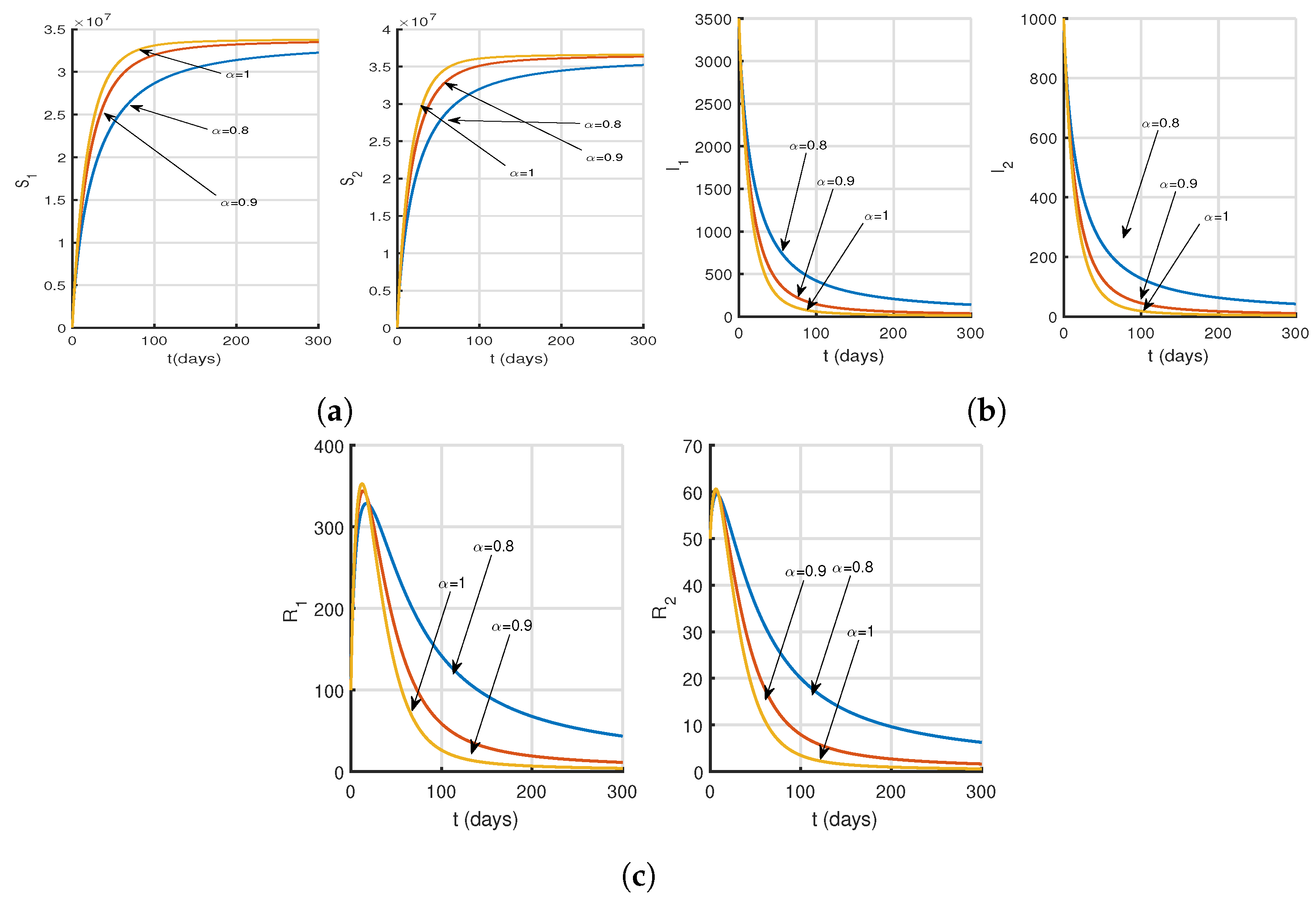
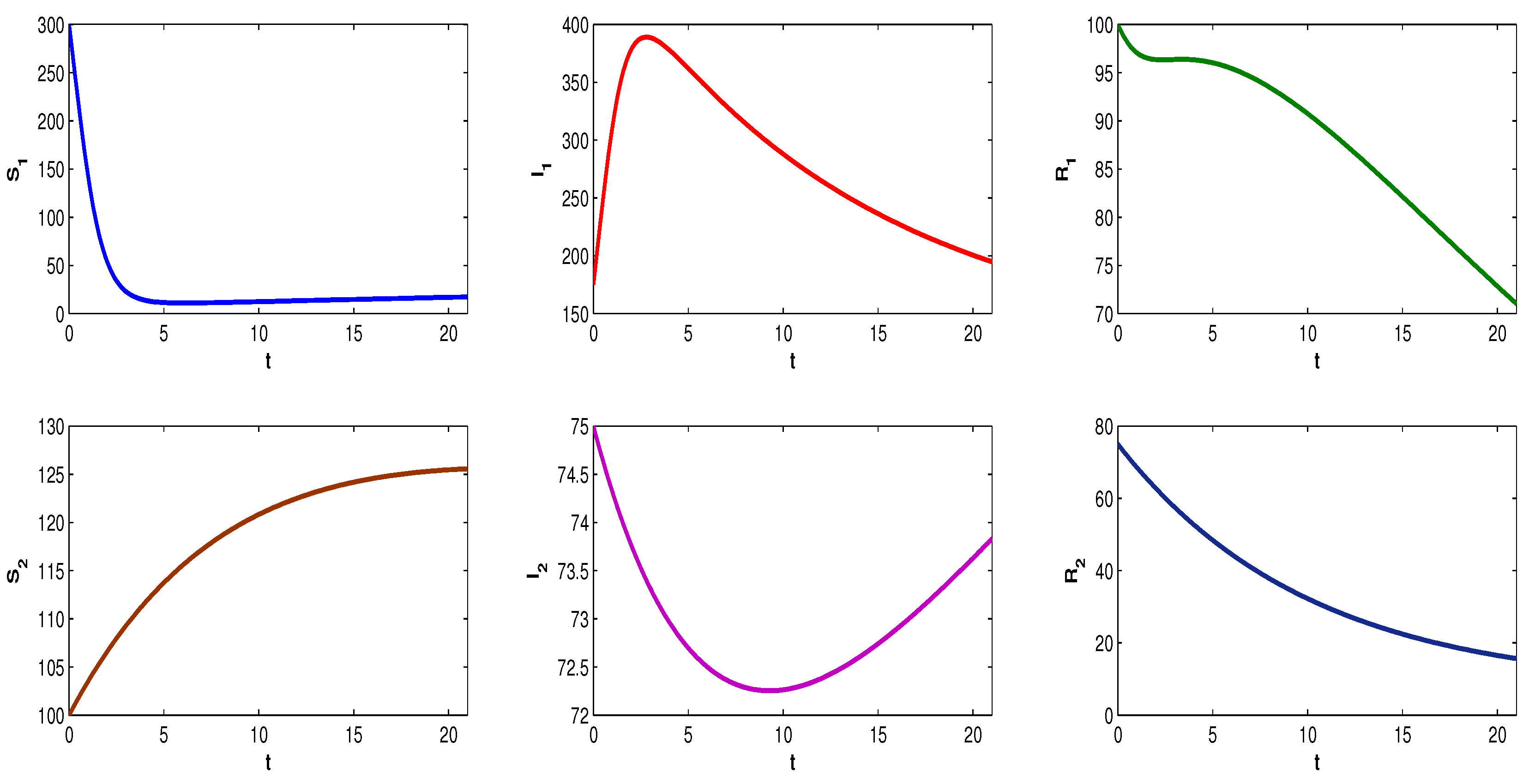
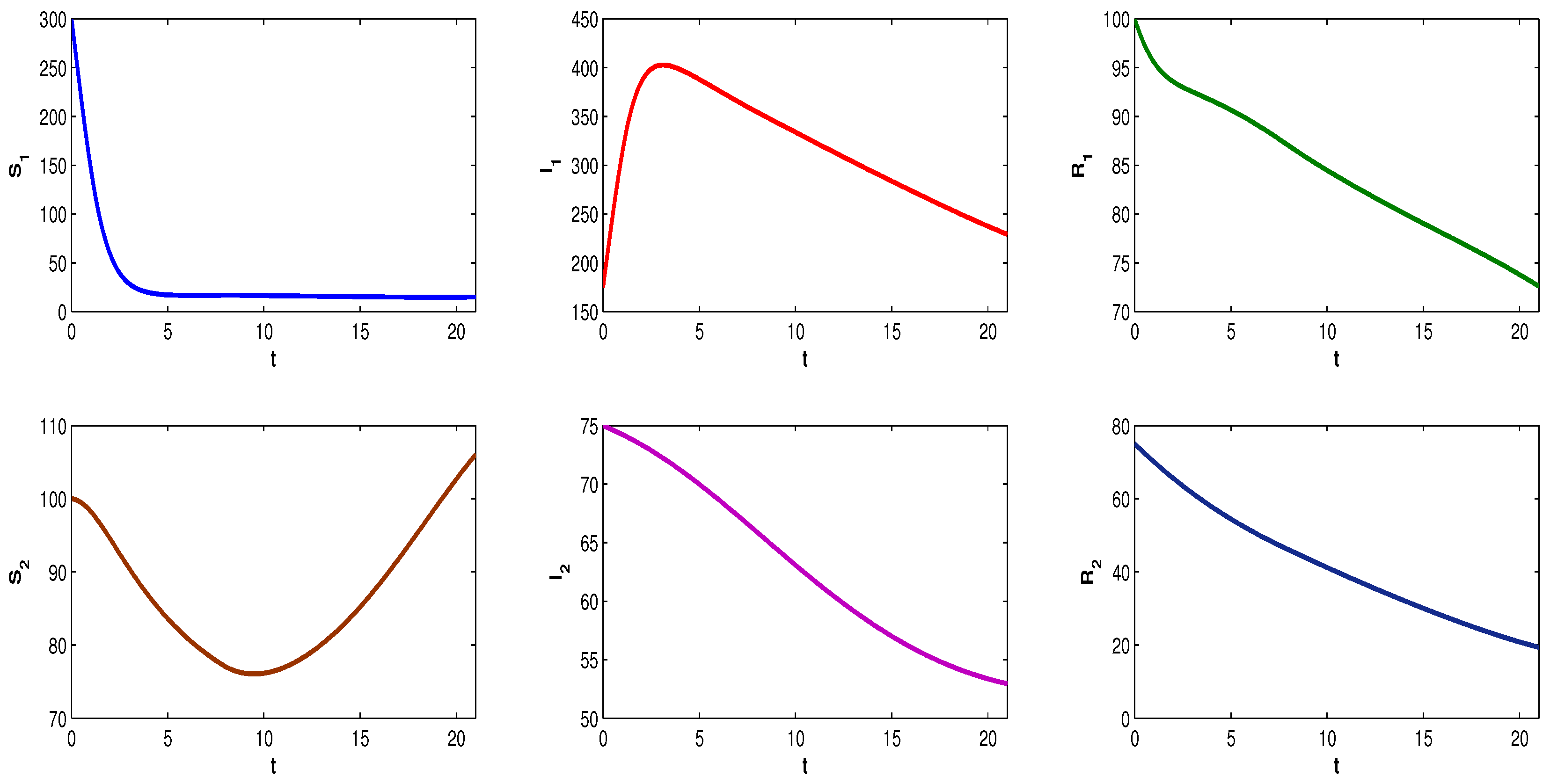

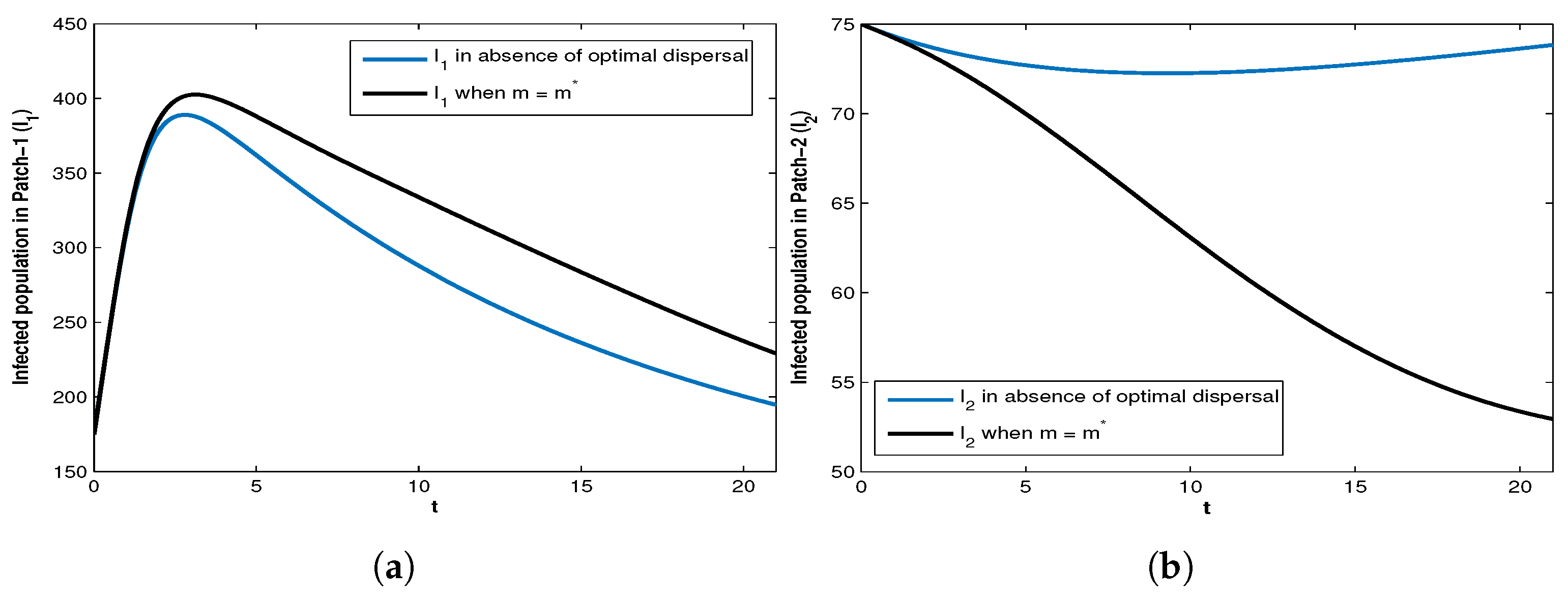
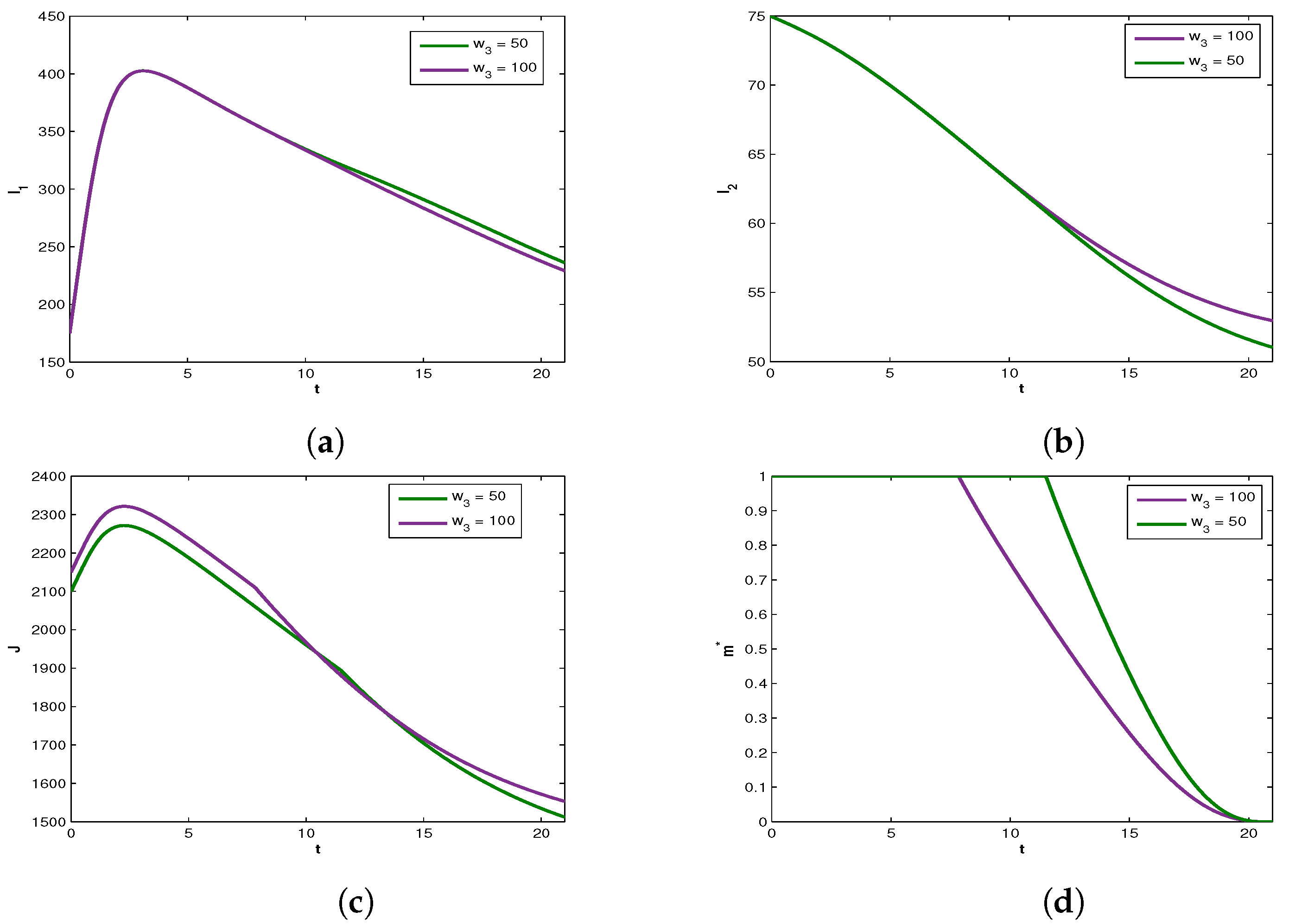
 ) colored curves, disease transmission rates are , while for green (
) colored curves, disease transmission rates are , while for green ( ) colored curves disease transmission rates are for .
) colored curves disease transmission rates are for .
 ) colored curves, disease transmission rates are , while for green (
) colored curves, disease transmission rates are , while for green ( ) colored curves disease transmission rates are for .
) colored curves disease transmission rates are for .
 ) colored curves for and red (
) colored curves for and red ( ) colored curves for .
) colored curves for .
 ) colored curves for and red (
) colored curves for and red ( ) colored curves for .
) colored curves for .